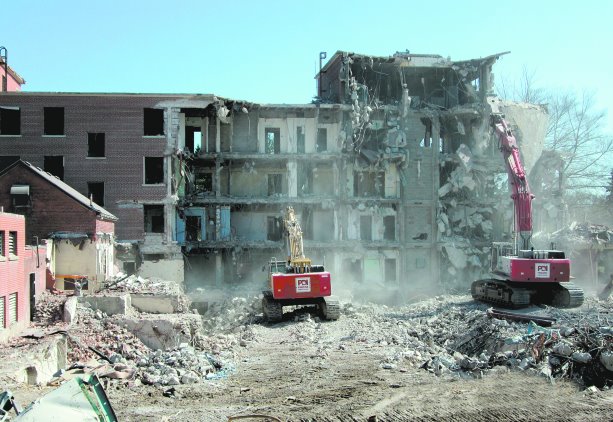Diverting some 93 per cent of materials from landfill by recycling or reusing them is an attainable goal on a major ICI demolition project – it just takes meticulous planning.
Such is the experience at the old Woodstock Hospital, whose original structures dated back to the 1900s, which was torn down and the land sold for redevelopment last year.
DST Consulting managed the project and took an aggressive stance on the diversion goal from the outset targeting 80 per cent. As a large ICI project it had to meet the minimum 60 per cent diversion under regulations 102 and 103 but they wanted to push it further.
"It was an Infrastructure Ontario project and we had to optimize diversion and to do that we prequalified every contractor to ensure they knew and understood the process," said George Thomas of DST. "Anyone with a large shovel and dump track and business card can call themselves a demolition contractor but it was important to have contractors in this province who are qualified and educated."
The $2 million contract involved ensuring each contractor for every phase included a diversion plan in their bid, he said, and then auditing on-site as the work progressed to ensure everything went to that plan.
Pretty quickly into the project, Thomas said, everyone started to realize 90 to 95 per cent diversion was in fact attainable.
He said things like metals are fairly easy, since they can be sorted on-site and then taken to local plants as appropriate for smelting. With concrete and brick, however, he said, it’s more of a challenge.
"The brick can be reused but you want a plan ahead of time because otherwise it sits in a yard waiting for someone to buy it," he said. "Still, the contractor has to assume that risk if that’s the plan."
In the case of Woodstock Hospital, the old bricks were torn down and cleaned and 1,000 of them were given back to the client who then gave them to staff as a memento of the old structure.
"We also had a few things we sold as furniture or fittings such as the stainless steel counters in the kitchens," he said. "There was an old cast iron style door on the old chimney stack and we sold that to a dealer as an item rather than sending it out as scrap because it had value."
One of the biggest challenges, of course, he said, is trying to deal with the concrete which is usually smashed up and sent to landfill or used as fill.
"What we did was set up a crusher on site so we avoided trucking the material and we crushed it there and used it as fill and it worked out very well," he said. "
"You have to make sure the concrete has no coating like tar but if not you can pulverize it," Thomas said. "All this was figured out in the design stage and we really reduced the carbon footprint by not having to haul 100,000 tonnes out and then bringing back clean fill, so we minimized truck traffic both ways."
With a structure that old with different additions over the years, asbestos was the first concern and so before anything else; work crews with hazmat suits came in and removed the asbestos insulation around old pipes.
Everything else, from roofing membrane, shingles, asphalt paving and even the old insulation foam panels were recycled or reused.
"A lot builders like the panels because they can use them on sites to insulate work areas," he said. "So that was reused as well."
Lumber from the older additions was de-nailed and chipped for reuse and the glass was also crushed for reuse.
"The key is the audit on site and having engineers there who can check the weigh tickets on a daily basis,’ he said.
DST’s next challenge is the demolition of Millbrook Correctional Centre which has some contamination issues such as lead paint and asbestos because of its age – it was built in 1957.
"There’s no basement to fill in there so we will have to look at what we’re going to do with the concrete waste," he said.












Recent Comments
comments for this post are closed